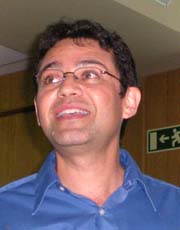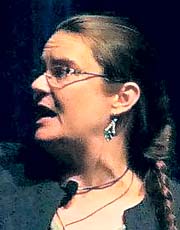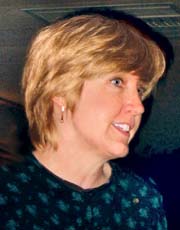Register
Click here to register by mail (pdf), and pay by check (deadline: received by Monday October 7).
On-line registration is not available for Fall 2013.
Fall 2013 SoCal-Nev Section Meeting
California State University Dominguez Hills
Saturday, October 12, 2013
(Directions and Map)
Tentative Program
- 8:00-12:00 Registration
James L. Welch Hall - 8:00 -10:30 Refreshments
James L. Welch Hall
- 8:00-9:00 Graduate Students drop-off Job Application Materials for Feedback
James L. Welch Hall - 8:30-4:10 MAA Book Sale
James L. Welch Hall
Organized by Richard Katz and Michael Hoffman, CSU, Los Angeles - 9:00-10:00 Invited Address by Jennifer Quinn, University of Washington
The Combinatorialization of Linear Recurrences
James L. Welch Hall Room D165 - 10:00-10:15 Section Business Meeting
James L. Welch Hall Room D165
- 10:30-12:30 Contributed Paper Session
Social and Behavioral Sciences (SBS) various rooms
View the call for papers
Organized by Gizem Karaali, Pomona College - 11:30-12:30 Section NExT Workshop by Gizem Karaali, Pamona College
Location TBA
Organized by Geoffrey Buhl, Cal State Channel Islands - 12:30-1:30 Lunch
Boxed Lunches provided by Subway - 1:30-2:30 Invited Address by Jesus De Loera, UC Davis
Not as innocent as they appear: The geometry of Magic Squares, Sudokus, Latin Squares and other mathematical tables
James L. Welch Hall Room D165 - 2:30-3:00 Refreshments
James L. Welch Hall - 2:45-3:00 Graduate Students pick up reviewed job application materials.
James L. Welch Hall - 3:00-4:00 Invited Address by Ann Watkins, CSU Northridge
Statistics Isn’t Mathematics: So How’s That Working Out?
James L. Welch Hall Room D165
Directions and Maps
For a campus map and driving directions, see the website at
http://www4.csudh.edu/campus-map-directions/
Parking: The nearest parking lot to Welch Hall is Lot 3 in the upper left corner of the campus map. Parking is $5 with permits available at the Parking Ticket Dispensers shown on the map. The campus honors faculty, student, and staff semester or full-year parking permits from other CSU campuses.
Lunch
Lunch is a Subway box lunch, consisting of a sandwich, chips, cookies, and a soft drink or water, for $7. The sandwich options are: Veggie Delite, Roast Beef, Oven Roasted Chicken, Turkey Breast, and Black Forest Ham.
Hotels
Here are two hotels near CSU Dominguez Hills:
Hampton Inn Los Angeles/Carson/Torrance
767 East Albertoni Street
Carson, CA 90746
(310) 768-8833
Doubletree By Hilton Hotel Carson
2 Civic Plaza Drive
Carson, CA 90745
(310) 830-9200
Register
Click here to register by mail (pdf), and pay by check (deadline: received by Monday October 7).
On-line registration is not available for Fall 2013.
Registration Fees
| Registration | |
| Nonmember | $45 |
| MAA Member | $40 |
| Student | $15 |
Subway box lunch |
|
| Add | $7 |
On-site registration will be available for the meeting, but will be $5 more than the pre-registration charge.
Jesus De LoeraUC Davis |
Jesús De Loera received his Bachelor degree in Mathematics from the National University of Mexico in 1989, a M.A. in Mathematics from Western Michigan in 1990, and his Ph.D in Applied Mathematics from Cornell University in 1995. An expert in the field of Discrete Mathematics, his work approaches difficult computational problems in Applied Combinatorics and Optimization using tools from Algebra, Combinatorics, and Convex Geometry. He has held visiting positions at the University of Minnesota, the Swiss Federal Technology Institute (ETH Zürich), the Mathematical Science Institute at Berkeley (MSRI), Universität Magdeburg (Germany), the Institute for Pure and Applied Mathematics at UCLA (IPAM), and the Technische Universität München. He arrived at UC Davis in 1999, where he is now a professor of Mathematics as well as a member of the Graduate groups in Computer Science and Applied Mathematics. His research has been recognized by an Alexander von Humboldt Fellowship, the 2010 INFORMS computer society prize, and a John von Neumann professorship at the Technical University of Munich. He is associate editor of the journals ``SIAM Journal of Discrete Mathematics'' and ``Discrete Optimization''. For his dedication to outstanding mentoring and teaching he received the 2003 UC Davis Chancellor's fellow award, the 2006 UC Davis award for diversity, the 2007 Award for excellence in Service to Graduate students by the UC Davis graduate student association and the 2013 Chancellor's award for mentoring undergraduate research. He has supervised eight Ph.D students, five postdocs, and over 20 undergraduate honors theses, with more than 40 undergraduates conducting and research with him. |
Not as innocent as they appear: The geometry of Magic Squares, Sudokus, Latin Squares and other mathematical tables
For hundreds of years people have been fascinated and played with the rectangular tables whose entries are non-negative integer and satisfy certain sum conditions. Famous examples include sudoku, magic and latin squares, etc. Even though some of the examples were born in recreational mathematics they have some rather interesting structure and connect with interesting applications in combinatorics, optimization and statistics (e.g.,think permutation matrices!). In this lecture I will recount the current knowledge we have about the geometry of the space of such tables and their multidimensional array generalizations. I will make the point of mentioning some rather surprising open questions about these cute mathematical beasts that could be explained to undergraduate students.
Jennifer QuinnUW Tacoma |
Jennifer Quinn is a professor of mathematics and Associate Director for Interdisciplinary Arts & Sciences at the University of Washington Tacoma. She earned her BA, MS, and PhD from Williams College, the University of Illinois at Chicago, and the University of Wisconsin, respectively. After twelve years teaching at Occidental College, rising to the rank of full professor and serving as Department Chair, Jenny left her tenured position to follow her husband to the Pacific Northwest. During that uncertain time, she had the privilege to serve as Executive Director for the Association for Women in Mathematics for two years while lecturing part-time at local Tacoma institutions. She was hired by UW Tacoma in 2007 to help create a non-existent mathematics curriculum in the newly expanded four-year institution and has thrived there ever since. Jenny received one of MAA's 2007 Haimo Awards for Distinguished College or University Teaching , the MAA's 2006 Beckenbach Book award for Proofs That Really Count: The Art of Combinatorial Proof , co-authored with Arthur Benjamin, and had the honor to co-edit Math Horizons (also with Arthur Benjamin) from 2004-2008. Over the years she has served on the boards or steering committees of the Spectrum Book series, Mathematics Magazine, Phi Beta Kappa Alpha Alumni Association of California, and Oregon Public Broadcasting's production Mathematics Illuminated. As a combinatorial scholar, Jenny thinks that beautiful proofs are as much art as science. Simplicity, elegance, and transparency should be the driving principles. She strives to bring this same ethic to her professional service and administrative work. |
The Combinatorialization of Linear Recurrences
Binet’s formula for the nth Fibonacci number, F_n= 1/√5 [((1+√5)/2)^n-((1-√5)/2)^n ], is a classic example of a closed form solution for a homogenous linear recurrence with constant coefficients. Proofs range from matrix diagonalization to generating functions to strong induction. Could there possibility be a better way? A more visual approach? A combinatorial method? This talk introduces a combinatorial model using weighted tiles. Coupled with a sign reversing involution, Binet’s formula becomes a direct consequence of counting exceptions. But better still, the weightings generalize to find solutions for any homogeneous linear recurrences with constant coefficients.
Ann WatkinsCSU Northridge |
Ann Watkins is Professor of Mathematics at California State University, Northridge (CSUN) and specializes in statistics education. Beginning as co-chair of the joint committee of the American Statistical Association and National Council of Teachers of Mathematics, Ann has worked for many years with high school teachers and statisticians to develop materials for teaching statistics and probability in secondary schools and the introductory courses in colleges and to design opportunities for professional development for teachers. She is a co-author of textbooks published as a result of the Quantitative Literacy, Activity-Based Statistics, and Core-Plus Mathematics projects. She chaired the College Board's Development Committee for Advanced Placement Statistics, was exam leader at AP Statistics readings, and was primary author of the AP Statistics Teacher's Guide. She was a member of the Board of Editors of the Journal of Statistics Education. She served as president of the Mathematical Association of America from 2001 to 2003, and has been MAA second vice-president, sectional governor, co-editor of the College Mathematics Journal, and associate editor of the American Mathematical Monthly. She has won the following CSUN awards: Outstanding Professor, Advancement of Teaching Effectiveness, and Extraordinary Service. In 1999, she was elected a Fellow of the American Statistical Association “for innovative contributions to curriculum and pedagogy; for masterful teaching, and teaching of teachers; and for an extraordinary record of sustained and successful efforts to institutionalize reform in statistics education." |
Statistics Isn’t Mathematics: So How’s That Working Out?
Mathematics and statistics faculty have different priorities concerning their overlapping interests in the school mathematics curriculum, the training of teachers, the Advanced Placement program, undergraduate majors, and the introductory statistics course. For example, statisticians believe that the introductory course taught by mathematicians has not kept up with statistical practice or the computing power now available. We will survey this and other issues that have arisen because of the separation of statistics from mathematics.
Contributed Paper Session
Faculty and students (undergraduate and graduate) are invited to submit short proposals for 15-minute talks in the Contributed Paper Session of the Fall 2013 Meeting.
This session accepts contributions in all areas of mathematics, including research and pedagogy, and all complete proposals will be considered.
The selection of talks will be based on interest to the expected audience, on common themes with other submissions, and on scheduling constraints. Since space and time are limited, acceptance may be prioritized based on the status of the speaker; first undergraduates (U), then graduate students (G), retirees (R), and faculty (F) in order of rank (lower rank has higher priority).
Submissions should contain a title, an abstract (not to exceed 150 words, should be suitable for inclusion in the conference program), the author(s) of the paper (with an indication of who the presenter will be), the desirable mathematical background of the audience, and any special presentation display needs(*). Do include in each submission the institutional affiliations of all authors if they have any, as well as their current status (U, G, R, or F). Select up to two of the categories below to indicate your main theme:
Education / Pedagogy;
History and Philosophy of Mathematics;
Interdisciplinary Topics;
Probability and Statistics;
Geometry and Linear Algebra;
Analysis;
Number Theory;
Graph Theory and Combinatorics;
Algebra and Topology;
Applied Mathematics;
Other Assorted Topics.
Please email all submissions to Gizem Karaali.
Ideally abstracts should be submitted in LaTeX format, with an accompanying PDF file. If you do not use LaTeX, please submit a Text document together with a PDF file.
The submission deadline is noon on Monday, September 30, 2013. Looking forward to your submissions!
CV, Research and Teaching Statement
Review for Graduate Students
Are you a graduate student or postdoc applying for faculty positions or other jobs this year?
Bring hard copies of your CV, Research Statement and/or Teaching Statement to the Fall Section meeting for review by a group of local mathematicians. They will help you look for ways to improve your application, so it is more competitive on the job market. To participate, please leave your materials at the registration table before 9:30 am, and they will be reviewed and ready for pick up around 3pm. You may bring academic and industrial CVs, which highlight different relevant achievements. The reviewers will return an evaluation rubric and feedback on the content and the presentation of your materials.
We wish you good luck in your job hunt!
